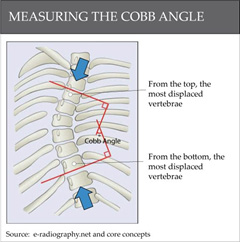OVERVIEW
Scoliosis is a condition which results in a curvature of the spine.
Symptoms of scoliosis may include:
- Obvious curvature of the spine
- Uneven shoulders

- One hip more prominent
- Sideways lean of the body
- One shoulder blade is higher than the other
- Uneven rib cage while bending forward
There is no cure for scoliosis, however there are various treatments that can improve a patient’s curve or prevent further curve progression.
IDIOPATHIC SCOLIOSIS

The most common type of scoliosis is idiopathic scoliosis, and its cause is unknown. Idiopathic scoliosis affects about 80% of patients with scoliosis. It is found more frequently in girls than boys and affects approximately 7 million people in the United States.
As scoliosis is so common, there are several incredibly talented athletes who have been diagnosed with the condition and have succeeded in their careers. James Blake, a retired American professional tennis player who reached a career high singles-ranking of No. 4 in the world was diagnosed with scoliosis at a very young age. He was required to wear a back brace until the age of 18, but was able to continue practicing, with a few minor adjustments to the way he trained. Several other world class athletes including Usain Bolt, Janet Evans, and Maritza Correia were successful in breaking records and competing at the highest levels in their professions.
COBB ANGLE & TREATING SCOLIOSIS
The optimal time to begin treating scoliosis is usually before the adolescent experiences rapid growth. Idiopathic scoliosis has the ability to progress rapidly during the

typical “growth spurt” of adolescence. Usually between the ages of 14 and 18, individuals have the highest chance of curve progression. An individual’s Cobb angle is the measure of thecurve in their spine which can be used to diagnose a patient with scoliosis. Typically, an individual is said to have scoliosis when their Cobb angle is above 10 degrees. Once the curve of the spine has reached a Cobb angle of 25 degrees, bracing is usually recommended. Unlike bracing, Schroth is recommended once an individual has been diagnosed because scoliosis is easier to treat in its early stages.
TYPES OF SCOLIOSIS
- Congenital Scoliosis: A type of scoliosis that you are born with which occurs because of an abnormal and incomplete development of the spine in the womb.
- Early Onset Scoliosis: A type of scoliosis wherein a curve appears at a young age, usually before the age of 10.
- Adolescent Idiopathic Scoliosis: A type of scoliosis resulting from a curvature in the spine when a child is growing where the spine curves sideways and rotates.
- Degenerative Scoliosis: A type of scoliosis occurring in adults.
- Neuromuscular Scoliosis: A type of scoliosis caused by a neurological or muscular condition.
DIAGNOSIS
Typically, adolescent idiopathic scoliosis is first noticed by a family member or pediatrician. The Adam’s forward bend test is used to look for asymmetry of the torso or shoulder blades. To measure the curve or rotation of the spine, a scoliometer is used. However, for a more accurate representation of the actual curve of the spine, X-ray images are taken and allow the doctor to assess the severity of the curve.
